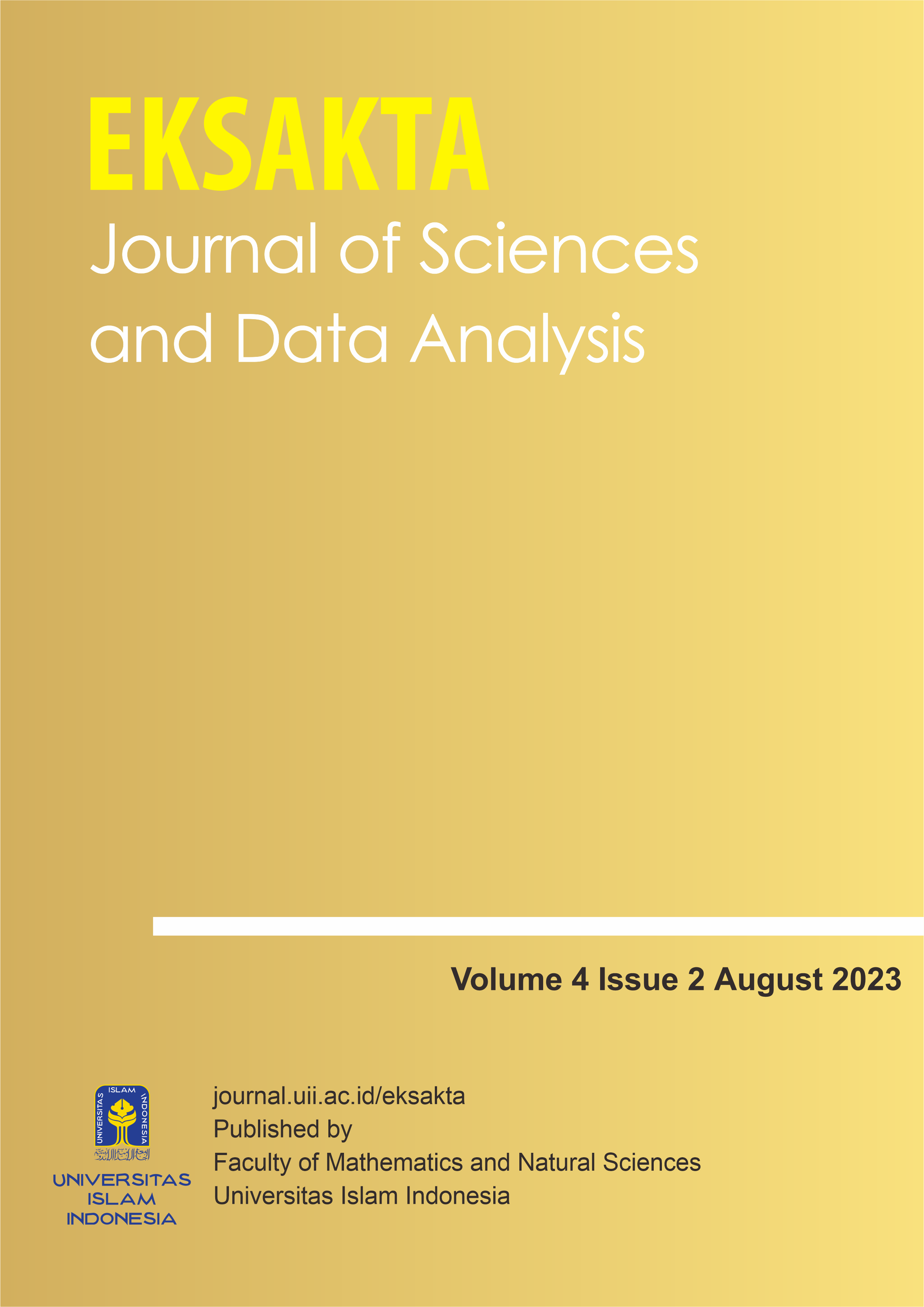Main Article Content
Abstract
Lead (Pb) can decrease children’s IQ and cognitive abilities. This study aims to analyze the risk characteristics of lead exposure in children aged 4-5 years related to the risk of low IQ as an obstacle in realizing “Indonesia Emas” of 2045 and to analyze the role of medical intelligence to anticipate these potential risks. This study was conducted in Tangerang Industrial Area. The Pb concentrations in food, urine, water, and rice were tested using Flame Atomic Absorption Spectrometry (FAAS). The results showed that Pb levels in food were lower than the Limit of Quantification (LOQ) method, thus, censored data rule was used for data processing. Overall results indicate a risk of causing long term cognitive impairment. However, The results of the calculation of exposure and Margin of Exposure (MOE) are based on the assumption of 50% and 100% of LOQ value. The obtained exposure and MOE values can not be used to said that the status of Pb exposure occurs. The resulting data is still useful as a basis for further research.
Keywords
Article Details
Authors who publish with this journal agree to the following terms:
- Authors retain copyright and grant the journal right of first publication with the work simultaneously licensed under a Creative Commons Attribution License that allows others to share the work with an acknowledgment of the work's authorship and initial publication in this journal.
- Authors are able to enter into separate, additional contractual arrangements for the non-exclusive distribution of the journal's published version of the work (e.g., post it to an institutional repository or publish it in a book), with an acknowledgment of its initial publication in this journal.
- Authors are permitted and encouraged to post their work online (e.g., in institutional repositories or on their website) prior to and during the submission process, as it can lead to productive exchanges, as well as earlier and greater citation of published work (See The Effect of Open Access).
References
- M. Santoso, D.D. Lestiani, M. Marselina, R. Mukhtar, Karakteristik Partikulat Udara Ambien dan Terespirasi di Sekitar Kawasan Industri Non-Formal, Indonesian Journal of Nuclear Science and Technology 17 (2016) 49-58. http://dx.doi.org/10.17146/jstni.2016.17.1.2342
- United Nations International Children's Emergency Fund, A Third of The World’s Children Poisoned by Lead, New Groundbreaking Analysis Says, UNICEF 2020. https://www.unicef.org/indonesia/press-releases/third-worlds-children-poisoned-lead-new-groundbreaking-analysis-says
- World Health Organization, Lead Poisoning, WHO 2023. https://www.who.int/news-room/fact-sheets/detail/lead-poisoning-and-health
- Kementerian PPN/ Bappenas, Indonesia 2045: Berdaulat, Maju, Adil, dan Makmur, BAPPENAS 2019. https://perpustakaan.bappenas.go.id/e-library/file_upload/koleksi/migrasi-data-publikasi/file/Policy_Paper/Ringkasan%20Eksekutif%20Visi%20Indonesia%202045_Final.pdf
- M. Reid, What is Censored Data, in Reliability: A Python Library for Reliability Engineering, 2019, Revision 4e332871. https://reliability.readthedocs.io/en/latest/What%20is%20censored%20data.html
- European Food Safety Authority Panel on Contaminants in the Food Chain (Contam), Scientific Opinion on Lead in Food, EFSA Journal, 8(4) (2010) 1570. https://doi.org/10.2903/j.efsa.2010.1570
- A.L. Wani, A. Ara, J.A. Usmani, Lead toxicity: a review, Interdiscip Toxicol 8(2) (2015) 55–64. https://doi.org/10.1515/intox-2015-0009
- E.B. Jørgensen, An International Pooled Analysis For Obtaining A Benchmark Dose For Environmental Lead Exposure in Children, EFSA Supporting Publications, 7(4) (2010) EN-47. https://doi.org/10.2903/sp.efsa.2010.EN-47
- European Food Safety Authority Scientific Committee, Update: Use of The Benchmark Dose Approach in Risk Assessment, The EFSA Journal 15(1) (2017) e04658. https://doi.org/10.2903/j.efsa.2017.4658
- Badan Pengawas Obat dan Makanan, Peraturan Kepala Badan Pengawas Obat dan Makanan Republik Indonesia Nomor 23 Tahun 2017 Tentang Batas Maksimum Cemaran Logam Berat Dalam Pangan Olahan, BPOM 2017. https://peraturan.go.id/files/bn1712-2017.pdf
References
M. Santoso, D.D. Lestiani, M. Marselina, R. Mukhtar, Karakteristik Partikulat Udara Ambien dan Terespirasi di Sekitar Kawasan Industri Non-Formal, Indonesian Journal of Nuclear Science and Technology 17 (2016) 49-58. http://dx.doi.org/10.17146/jstni.2016.17.1.2342
United Nations International Children's Emergency Fund, A Third of The World’s Children Poisoned by Lead, New Groundbreaking Analysis Says, UNICEF 2020. https://www.unicef.org/indonesia/press-releases/third-worlds-children-poisoned-lead-new-groundbreaking-analysis-says
World Health Organization, Lead Poisoning, WHO 2023. https://www.who.int/news-room/fact-sheets/detail/lead-poisoning-and-health
Kementerian PPN/ Bappenas, Indonesia 2045: Berdaulat, Maju, Adil, dan Makmur, BAPPENAS 2019. https://perpustakaan.bappenas.go.id/e-library/file_upload/koleksi/migrasi-data-publikasi/file/Policy_Paper/Ringkasan%20Eksekutif%20Visi%20Indonesia%202045_Final.pdf
M. Reid, What is Censored Data, in Reliability: A Python Library for Reliability Engineering, 2019, Revision 4e332871. https://reliability.readthedocs.io/en/latest/What%20is%20censored%20data.html
European Food Safety Authority Panel on Contaminants in the Food Chain (Contam), Scientific Opinion on Lead in Food, EFSA Journal, 8(4) (2010) 1570. https://doi.org/10.2903/j.efsa.2010.1570
A.L. Wani, A. Ara, J.A. Usmani, Lead toxicity: a review, Interdiscip Toxicol 8(2) (2015) 55–64. https://doi.org/10.1515/intox-2015-0009
E.B. Jørgensen, An International Pooled Analysis For Obtaining A Benchmark Dose For Environmental Lead Exposure in Children, EFSA Supporting Publications, 7(4) (2010) EN-47. https://doi.org/10.2903/sp.efsa.2010.EN-47
European Food Safety Authority Scientific Committee, Update: Use of The Benchmark Dose Approach in Risk Assessment, The EFSA Journal 15(1) (2017) e04658. https://doi.org/10.2903/j.efsa.2017.4658
Badan Pengawas Obat dan Makanan, Peraturan Kepala Badan Pengawas Obat dan Makanan Republik Indonesia Nomor 23 Tahun 2017 Tentang Batas Maksimum Cemaran Logam Berat Dalam Pangan Olahan, BPOM 2017. https://peraturan.go.id/files/bn1712-2017.pdf




